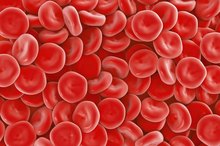About Rectal Bleeding and Liver Disease
Rectal bleeding can be a symptom of many different conditions and should always be checked out by a medical professional. Depending on the way it appears, the gastrointestinal bleed can come from different areas of the body, and be due to several underlying conditions. One serious possible cause of rectal bleeding is esophageal varices, which are indicative of liver cirrhosis, a dangerous and potentially fatal disease which should be treated immediately by a doctor.
Significance
Rectal bleeding can be a symptom of many different kinds of disease. Often, it will be first noticed as blood seen in bowel movements, and occasionally as a sort of dark black stool called melena. Rectal bleeding is a sign of bleeding somewhere in the gastrointestinal tract and always requires advice from a medical professional as soon as possible.
Effects
What Causes Blood Clots in Stools?
Learn More
Mild gastrointestinal bleeding can go unnoticed for a long period of time unless discovered during a examination by a hemoccult test, which is a way to detect small amounts of blood in the stool. Mild bleeding over a long time can result in iron deficiency anemia, as chronic bleeding can deplete the body of iron. More severe cases can present with more obvious symptoms of anemia, such as paleness, dizziness, shortness of breath, and weakness. If the bleeding is especially severe, hospitalization may be necessary, especially if the patient goes into shock. Hypovolemic shock occurs when about 40% of the body's blood is lost. This is a serious condition and must be treated immediately with IV fluids and, possibly, blood transfusions.
Types
Bleeding can happen from many places in the gastrointestinal system, each with its own cause. Bright red blood in the stool usually indicates a bleed very near the rectum, often due to hemorrhoids, though other conditions such as colon polyps or infections can also cause it. Black, tarry stools can result from a bleed earlier in the system, possibly from an ulcer that has formed in the esophagus, stomach lining, or the duodenum (the first part of the small intestine), or from esophageal varices. Esophageal varices, which are varicose veins in the esophagus, are a very serious condition and are indicative of liver cirrhosis.
Effects
Symptoms of Decreased Liver Function
Learn More
Esophageal varices happen when certain veins in the esophagus get extremely dilated, allowing them to easily rupture and bleed. These vessels dilate in response to portal hypertension, which is often a consequence of cirrhosis and liver disease. Portal hypertension occurs when blood flow through the liver becomes obstructed, causing the blood to be routed through other veins in the esophagus, stomach, abdominal wall, and rectum. These veins are thin-walled and not designed to handle higher pressures, so they swell and become vulnerable to rupturing. Although it is possible to close off these swollen and damaged blood vessels, it is often more difficult to treat the underlying portal hypertension because it is caused by liver cirrhosis.
Expert Insight
Liver cirrhosis happens as a result of long-term chronic liver disease that ultimately leads to the loss of liver tissue. This tissue is replaced by small nodules of regenerating tissue and fibrous scar tissue. Common causes of cirrhosis include alcoholism, hepatitis B and C, and the progression of fatty liver disease, but sometimes cirrhosis has no identifiable cause. One of the most common complications of cirrhosis is the accumulation of fluid in the abdomen, called ascites, which raises the risk of infection. Cirrhosis is generally irreversible once it happens, and most treatments aim to slow the progression and to treat complications. For advanced cases, the only treatment is a liver transplant.
Related Articles
Resources
Writer Bio
Adam Cloe has been published in various scientific journals, including the "Journal of Biochemistry." He is currently a pathology resident at the University of Chicago. Cloe holds a Bachelor of Arts in biochemistry from Boston University, a M.D. from the University of Chicago and a Ph.D. in pathology from the University of Chicago.






